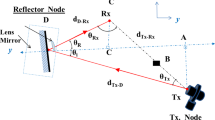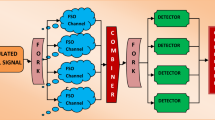Abstract
A non-line-of-sight (NLOS) infra-red reflection based beam propagation model is proposed as a supplement to conventional terrestrial free space optical (FSO) communication system. This ray propagation model lets tactically positioned optical reflectors to smartly exploit the aggregated advantages of mirror characteristics to bridge the existent communication gap between two FSO nodes due to inclined or obstructed line-of-sight view. Additionally, a numerical framework of the proposed system is presented that analytically explores the optical losses induced by harmonic distortions and the resultant beam divergence at the receiver. The impact of the different reflectors on the traversing beam is then investigated through an experimental FSO test-bed set in an outdoor environment in terms of phase shifts, divergence loss, noise margin and maximum achievable link length. Matlab based simulations, based on the experimental outcomes, envisages that concave reflectors can effectively compensate the turbulence induced signal fading and restrict the beam divergence loss; thereby, improving the maximum achievable NLOS FSO link length.













Similar content being viewed by others
References
Badar, N., Jha, R.K.: Performance comparison of various modulation schemes over free space optical (FSO) link employing Gamma–Gamma fading model. Opt. Quant. Electron. 49(192), 1–10 (2017)
Billabert, A.L., Deshours, F., Moreno, L., Algani, C., Rumelhard, C.: Modulator non linearity influence on UWB signal performance over RoF link. In: Proceedings of the European Microwave Conference, pp. 1249–1252 (2011)
Binh, L.N.: Optical Fiber Communication Systems with MATLAB® and Simulink® Models. CRC Press/Taylor and Francis Group, Boca Raton/London (2015)
Bosu, R., Prince, S.: Perturbation methods to track wireless optical wave propagation in a random medium. J. Opt. Soc. A 33(2), 244–250 (2016)
Chalise, B.K., Vandendorpe, L.: Performance analysis of linear receivers in a MIMO relaying system. IEEE Commun. Lett. 13(5), 330–332 (2009)
Chen, G., Xu, Z., Ding, H., Sadler, B.: Path loss modeling and performance trade-off study for short-range non-line-of-sight ultraviolet communications. Opt. Express 17(5), 3929–3940 (2009)
Ghassemlooy, Z., Popoola, W.O., Rajbhandari, S.: Optical Wireless Communications System and Channel-Modelling with MATLAB®. CRC Press, Boca Raton (2013)
Halliday, D.: Walker: Fundamentals of Physics. Wiley India Pvt Ltd, New Delhi (2013)
Hulea, M., Ghassemlooy, Z., Rajbhandari, S., Tang, X.: Compensating for optical beam scattering and wandering in FSO communications. J. Lightw. Technol. 32(7), 1323–1328 (2015)
Keiser, G.: Optical Fiber Communications. Tata McGraw-Hill Education, New Delhi (2008)
Li, M., Li, Y., Han, J.: Gerchberg–Saxton algorithm based phase correction in optical wireless communication. Phys. Commun. 25, 323–327 (2017)
Li, Y., Pappas, N., Angelakis, V., Pióro, M., Yuan, D.: Optimization of free space optical wireless network for cellular backhauling. IEEE J. Sel. Areas Commun. 33(9), 1841–13854 (2015)
Liu, X., Wang, P., Liu, T., Li, Y., Guo, L., Tian, H.: ABER performance of LDPC-coded OFDM free-space optical communication system over exponentiated Weibull fading channels with pointing errors. IEEE Photon. J. 9(4), Article No. 7905113 (2017)
Madani, M.H., Abdipour, A., Mohammadi, A.: Analysis of performance degradation due to non-linearity and phase noise in orthogonal frequency division multiplexing systems. IET Commun. 4(10), 1226–1237 (2010)
Majumdar, A.K.: Advanced Free Space Optics (FSO): A Systems Approach. Springer, New York (2015)
Noshad, M., Pearce, M.B., Wilson, S.G.: NLOS UV communications using M-ary spectral-amplitude-coding. IEEE Trans. Commun. 61(4), 1544–1553 (2013)
Pasian, M., Bozzi, M., Perregrini, L.: Accurate modeling of dichroic mirrors in beam-waveguide antennas. IEEE Trans. Antennas Wave Propag. 61(4), 1931–1938 (2013)
Senior, J.M.: Optical Fiber Communications: Principles and Practice. Pearson Education, London (2009)
Shang, J., Nan, Z., Liu, S., Qiu, C., Xin, X.: Performance analysis of QPSK in free-space optical communications systems over combined channel with phase compensation error. Opt. Quant. Electron. 47(2555), 2555–2563 (2015)
Silva, M.: Cable and Wireless Networks: Theory and Practice. CRC Press, Boca Raton (2016)
Song, T., Wang, Q., Wu, M.W., Kam, P.Y.: Performance of laser inter-satellite links with dynamic beam waist adjustment. Opt. Express 24(11), 11950–11960 (2016)
Sun, Y., Gong, C., Xu, Z., Zhan, Y.: Link gain and pulse width broadening evaluation of non-line-of-sight optical wireless scattering communication over broad spectra. IEEE Photon. J. 9(3), 1–13 (2017)
Tang, X., Wang, Z., Xu, Z., Ghassemlooy, Z.: Multihop free-space optical communications over turbulence channels with pointing errors using heterodyne detection. J. Lightw Technol. 32(15), 2597–2604 (2014)
Viswanath, A., Jain, V.K., Kar, S.: Aperture averaging and receiver diversity for FSO downlink in presence of atmospheric turbulence and weather conditions for OOK, M-PPM and M-DPPM schemes. Opt. Quant. Electron. 48(435), 1–20 (2016)
Wang, L., Xu, Z., Sadler, B.M.: An approximate closed-form link loss model for non-line-of-sight ultraviolet communication in non-coplanar geometry. Opt. Lett. 36(7), 1224–1226 (2011)
Wang, P., Yang, B., Guo, L., Shang, T.: SER performance analysis of MPPM FSO system with three decision thresholds over exponentiated Weibull fading channels. Opt. Commun. 354, 1–8 (2015)
Xu, Z., Chen, G., Galala, A., Leonardi, M.: Experimental performance evaluation of non-line-of-sight ultraviolet communication systems. In: Proceedings of the SPIE, pp. 1–12 (2007)
Yong, Z., Jian, W., Houfei, X., Jintong, L.: Non-line-of-sight ultraviolet communication performance in atmospheric turbulence. China Commun. 10(11), 52–57 (2013)
Author information
Authors and Affiliations
Corresponding author
Appendices
Appendix A: Estimation of zenith angle of the optical reflector
Here, 3 FSO nodes with 1 reflector (n = 1, i = {0, 1, 2}, n ∈ i) are considered for collecting the laser beam, relayed from Tx (i = 0) node, at the mirror installed at ith node i.e. (i = 1), and then precisely reflect it within FOV of Rx (i = 2) node. Figure 14 illustrates an alternate obstruction-less NLOS beam propagation path in the y–z plane when the LOS view between Tx and Rx is blocked.
Within the ray-pointing loci, the arms of the triangle, with vertices as the FSO nodes, represent the propagation path of the beam from i = 0 to i = 2, via the mirror MM′ installed at reflector node i = 1. Consequently, the interior angle of the triangle formed at the node i = 1, is bisected by a line N so that the beam incident angle θ I equals the reflected angle θ R (to satisfy the laws of mirror reflection (Halliday 2013)). This implies that the mirror plane MM′, traced as a perpendicular to mirror’s normal N, may bear an angular tilt of \(\phi_{i = 1}^{ze}\) from z-axis at node i = 1, and is obtained as,
after applying the trigonometric manipulations. Here, the angular tilt ϕ(i,j) of the beam from node i to j is given by
and is uniquely specified for node installation heights: hi=2 > hi=1 > h obstacle > hi=0. Note that li=0,i=2 denotes the horizontal distance between nodes: 0 and 2, and the zenith angle is positive when it is measured in clockwise direction along z-axis. By following a similar approach, the zenith angles of n reflectors, installed at their respective nodes, in a NLOS FSO link with i (= 0, 1, …, n + 1) nodes can be easily gauged in x–z and y–z planes.
Appendix B: Estimation of azimuth angle of the optical reflector
Figure 15 illustrates an alternate obstruction-less NLOS beam propagation path in the x–y plane when the LOS view between Tx and Rx nodes is blocked. Here, the NLOS FSO link comprises of 3 static link nodes with 1 reflector (n = 1, i = {0, 1, 2}, n ∈ i) for collecting the laser beam relayed from Tx (i = 0) node. Subsequently, the mirror installed at ith node i.e. (i = 1) precisely reflect it within FOV of Rx (i = 2) node. Note that the beam traversal paths (Li=1,i=2, Li=1,i=0) between the FSO nodes forms a triangle, with blocked LOS axis, with interior angles (θi=0, θi=1, θi=2). Thereafter, trace a reflector plane MM′ through the reflector node (i = 1) perpendicular to the angle bisector of θi=1, such that θi=1 = θ I +θ R and the beam incident angle θ I equals the beam angular tilt of \(\phi_{i = 1}^{a}\) from x-axis and is given by reflected angle θ R . During such ray drafting procedure, the mirror plane MM′ will bear an
where the beam incidence angle at node i = 1, with further geometric manipulations, is given as,
and the angular tilt ϕ(i,j) of the beam from node i to j is given by: ϕ(i,j) = arcsin(L i,j /l i,j ). By following a similar approach, the azimuth angles of n reflectors, installed at their respective nodes, in a NLOS FSO link with i (= 0, 1, …, n + 1) nodes can be easily gauged.
Rights and permissions
About this article
Cite this article
Bosu, R., Prince, S. Reflection assisted beam propagation model for obstructed line-of-sight FSO links. Opt Quant Electron 50, 116 (2018). https://doi.org/10.1007/s11082-018-1381-8
Received:
Accepted:
Published:
DOI: https://doi.org/10.1007/s11082-018-1381-8






